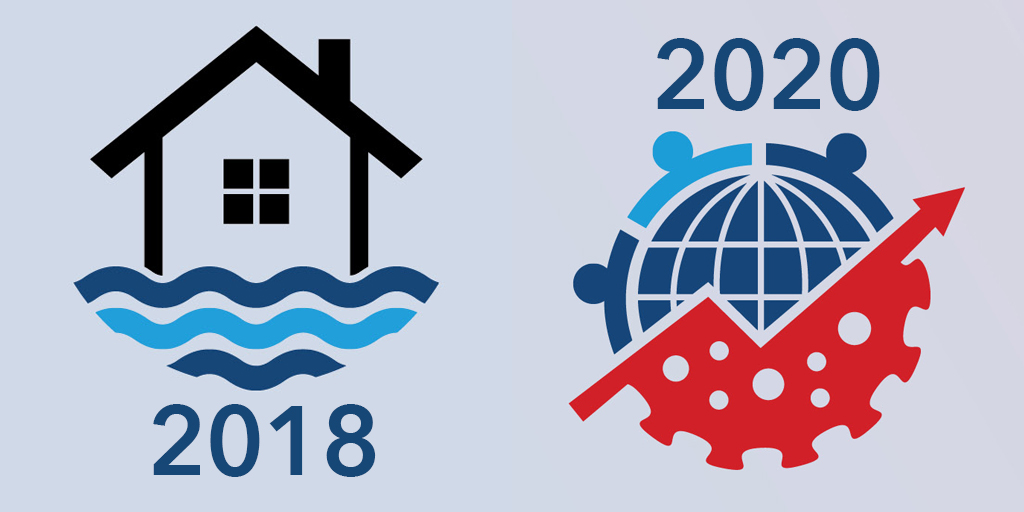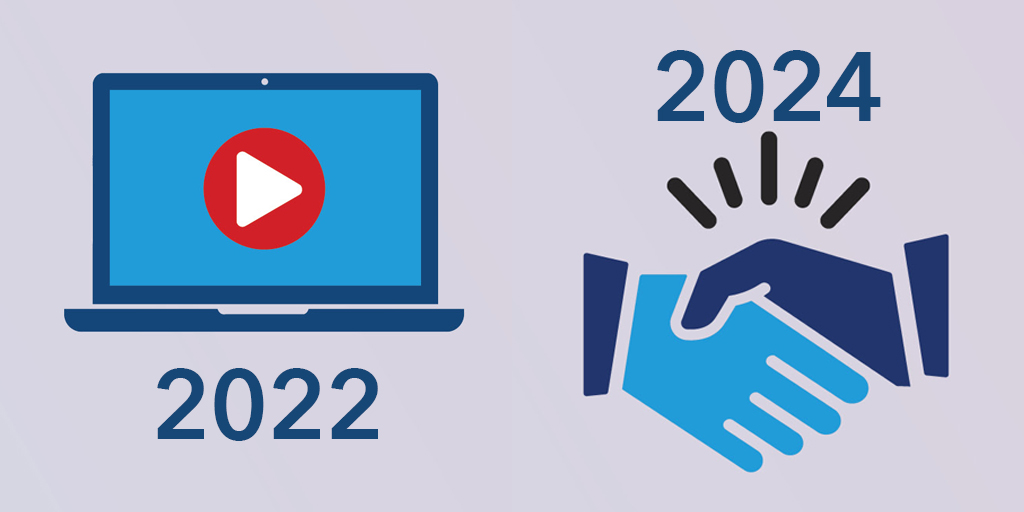
By Michael G. Malloy
From its 1965 founding to the age of artificial intelligence, the Academy has adapted to meet the moment. Past presidents reflect on six decades of progress—and the challenges and opportunities that shape the profession.
In 1965, President Lyndon B. Johnson signed Medicare into law, and Social Security turned 30 years old. In sports, the NFL was a little more than a season away from Super Bowl I, and heavyweight champion Muhammad Ali defeated Sonny Liston for the second time, in a first-round knockout. In popular culture, Sonny & Cher had a radio hit with “I Got You Babe,” fictional “Mad Men” New York ad man Don Draper took his 11-year-old daughter Sally to see The Beatles at Shea Stadium, and The Sound of Music topped the year’s big-screen box office.
And, on Oct. 25, at shortly after 4 p.m., the American Academy of Actuaries was founded to be the voice of the U.S. actuarial profession on public policy issues and professionalism with Henry Rood as its first president. The Academy’s Charting the Course book, published in 2015 marking its 50th anniversary, gives a comprehensive overview of key events in the organization’s first half-century, and the actuarial profession’s historical roots in the United States going back to around 1800, shortly after the nation’s founding.[1]
In the past decade, the Academy has continued its growth and evolution, adeptly shifting gears at the outset of COVID-19 in 2020—releasing issue briefs, other publications, and holding webinars on the pandemic’s effects on everything from health care to financial-system solvency. It moved its annual meeting online that year and since then, it has continued adapting, adopting a hybrid format, refreshing its many delivery formats and communication channels, and making significant investments in new technologies and practices to best serve the growing needs of its more than 20,000 members practicing in the U.S.
Contingencies asked six former Academy presidents to share their perspectives on the Academy’s journey: Jim MacGinnitie (1989), Mavis Walters (1991), Larry Zimpleman (1997), Tom Wildsmith (2016), Bob Beuerlein (2017), and Maryellen Coggins (2022). (Each began their term late in the preceding year and served through most of the year shown.)
MacGinnitie, a charter member of the Academy, noted a bevy of changes in the past six decades, with changes “from punch cards to the cloud, with the attendant massive increase in the amount of data and the sophisticated software and algorithms to use it. Health care has grown enormously, with more sophisticated actuarial practice required. Natural catastrophes and their modeling have grown, [as has] international actuarial practice,” he said.
“I think probably everyone back then did” join the Academy, MacGinnitie said. “In my area, casualty, rating bureaus were dominant; a large fraction of the casualty actuaries either worked at the bureaus or served on their committees,” he added. “The nature of a profession is to build on the past and pass it on to the next generation. The Academy afforded me an opportunity to do so, for which I am grateful.”
The profession in 1965 was much smaller, including membership at groups like the Casualty Actuarial Society (CAS) and the Society of Actuaries (SOA), which predated the Academy’s founding. Actuaries were largely focused on insurance companies and pension plan sponsors, MacGinnitie said.

“As a relatively small profession—and one that unfortunately often bears unwelcome news—it’s important to have a competent and professional organization like the Academy to develop relationships and communication channels with those outside groups,” said MacGinnitie, who later served as Academy Senior Casualty Fellow from September 2015 to September 2017.
Mavis Walters, the Academy’s first woman president (see sidebar, “Women’s Growing Leadership Roles in the Profession,” on page 18), said that being involved with the Academy gave her exposure to actuaries in other practice areas and a greater appreciation for those areas. “I think that’s very valuable in bringing a whole actuarial profession together, in the roles that others play,” Walters said. “The Academy is the only organization that makes statements on public policy,” which heightens the importance of accuracy in such statements.
Walters, who also served as CAS president and chaired The Actuarial Foundation’s board, said that in her various leadership roles she always emphasized the profession’s objectivity, which is core to how the Academy operates.
She introduced political leaders speaking on the budget at a 1990 luncheon in Washington, and said that in her former job she also had testified many times on Capitol Hill, noting the importance of translating often complex issues into understandable language for lawmakers and others. “Congress was always looking for data, and I would often say, ‘Senator or Congressman, I don’t have that answer right now, but if I did, how would it help you?’”
An Evolving Role
Bob Beuerlein, from the life practice area, also noted the evolving role of the Academy and the actuarial profession.
“Over the past 60 years, the role of a professional actuary has changed significantly due to expanded responsibilities, the ever-changing environment of issues, and the continuing evolution of tools available,” Beuerlein said. “While a four-function pocket calculator was once deemed to be revolutionary, the technical tools have become more sophisticated so that ChatGPT AI [artificial intelligence] is [becoming] commonly used by the American public.
“The DNA of Academy members has remained the same” over the years, Beuerlein said. “Inherent in each member is the obligation to perform actuarial services with honesty, integrity, and competence, in an unbiased and objective manner, so as to maintain the public trust. The development of standards by the ASB [Actuarial Standards Board], the USQS [U.S. Qualification Standards], and the Code [of Professional Conduct] have all occurred since the Academy’s founding. All have been huge contributors to more consistent and professional actuarial services being performed in the U.S.”

Beuerlein noted more recent Academy adaptations to challenges faced by U.S. actuaries. For instance, in the second half of 2025, the Academy sought member input in establishing a process to identify and understand the implications of potentially disruptive events.
Women’s Growing Leadership Roles in the Profession
Academy Past Presidents Mavis Walters and Maryellen Coggins both said they have seen growing representation by women in the actuarial profession over the decades.
Walters paraphrased another Academy president, Barbara Lautzenheiser (2004), who said that being a woman is like being a petunia in the onion patch—everyone is going to notice you, and you’re going to stand out. So the pressure is on to be competent and be the best you possibly can.
In her case, Walters said she “didn’t consider it groundbreaking when I was elected president, because I had put in a lot of time on committees and professionalism activities at the Academy. I was happy to serve and got to know a lot of women who became presidents of other actuarial organizations. I never considered myself the first woman of anything, it was just the way it was.

“When I was visiting local actuarial organizations, or student groups, I would tell people the beauty of the actuarial profession was you had an objective measure of your potential—including passing your exams. Examiners don’t know if you’re a man or a woman, they only know your number.”
Besides the role of changing technology, Coggins—who served as the Academy’s sixth woman president in 2022—said that throughout her career she has seen the growing role of female actuaries in the in the profession. Incoming President Tricia Matson will be the Academy’s eighth female president, and four of the last eight presidents have been women.
“In my early years—and I’m sure it was more so for Mavis—it was extremely common to be in senior management or board meetings that consisted entirely of men,” Coggins said. “Today, we see female actuaries in a wide variety of leadership positions. Seeing so many more women rise to actuarial leadership positions than when I began by career has been truly gratifying,” she said, adding that in the year she served as Academy president, the presidents of all five U.S. actuarial organizations were women, “which certainly felt like a notable achievement.”
Coggins added that “we know that there’s lots more work to do to attract women to and support women within the profession [and we are] … “really fortunate to have a number of affinity groups that are making a difference in actuarial representation, including the Network of Actuarial Women and Allies, which is one such group that’s focused on supporting women in the profession, which is fantastic.”
“The world continues to change, and the Academy is changing to adapt to all of this,” Beuerlein said.
The Academy book Charting the Course included a quote by another past president, Tom Terry (2014): “The problems of the nation’s biggest and most financially stressed programs are all actuarial in nature.”[2] The Academy aims to highlight the actuarial perspective and how it is essential when looking at those problems with solutions that are independent, objective, and balanced.
“I think that still holds up very well today,” said Zimpleman, who practiced in the retirement area. “Whether it’s flood insurance, Medicare and Medicaid, or Social Security, legislators and government get into those areas that private industry can’t fill, in a politically feasible way that’s not always financially feasible. Over time, we find that those programs need a lot of help, and that’s where actuaries come in.”
Beuerlein added that “many of the nation’s financial problems can be analyzed using actuarial techniques. However, the bigger question is, ‘What do actuaries do about this?’”
He likened it to the difference between a thermometer and a thermostat. “A thermometer can precisely analyze and report on the temperature of a room, but does not have an effect on the temperature. A thermostat can also determine the temperature of a room, but can also impact the environment by sending a signal to the air conditioner or furnace to adjust the temperature to the desired level,” Beuerlein said. “As actuaries, we need to be more like thermostats—by prudently striving to influence the environment as we analyze problems, both small and large.”
Wildsmith, from the health practice area, noted that the tools and techniques used by actuaries have changed dramatically over his career. “When I started, I did spreadsheets by hand on large, pre-printed paper pads—I used a pencil, because mistakes happen! Since then, I’ve seen the introduction of personal computers, email, the internet, instant messaging, video conferencing, telework, and now generative AI,” he said—all of which have transformed the way actuaries do their job.
“It’s been at least 30 years since I’ve heard an executive ask a secretary to type a letter,” Wildsmith said. “The insurance and retirement products and programs we work with have also changed. As computing technology has progressed, our models have become more complex and refined.”
But he added that “the core of the work itself—analyzing the financial impact of uncertain future events to ensure the soundness of financial security programs—has not changed. The professional responsibility we have toward the public has not changed. The importance of our work to the millions of individuals, families, and businesses who rely on the products and programs we support has not changed. And the Academy’s commitment to its mission to serve the public and U.S. actuarial profession has not changed.”
Wildsmith, who became president during the Academy’s 50th year in 2015, said the Academy has “held up quite well” in the past decade, and over its history. “Social Security and Medicare’s financial challenges are well understood, as are the demographic trends driving them. Those technical challenges are all actuarial in nature. The fact that we understand the financial challenges facing these programs is due to the hard work of the government actuaries who perform the calculations that underlie the annual [Medicare and Social Security] trustees reports.”
He added that “solving Social Security and Medicare’s financial problems isn’t a purely actuarial exercise—it will require the political will to make some difficult choices.”
Making an Impact
Zimpleman, who spent his entire 45-year career with Principal in Des Moines, Iowa, including as chairman and CEO from 2008–2016, said that, “Outside of my company, joining the Academy was the most impactful thing in my career. I’m a big believer in volunteering and getting involved [with actuarial organizations]. My personal preference was the Academy, because the challenge with the Academy as a public interface was taking the fairly complicated world of actuarial science and communicating it to those who have an impact on our work but don’t have the technical grasp. That’s hard, but it’s very fulfilling when you’re able to do that.”
Following the historic passage of the Employee Retirement Income Security Act of 1974, better known as ERISA, there was at least one piece of retirement legislation every year from the early 1980s and into the 2000s. (The Academy held an “ERISA at 50” symposium in 2024 examining the milestone law’s legacy; see the timeline.)
“There was a lot of activity by the Academy in the retirement space—and in other areas—too, to engage in this legislative interface and get to a much better place, whether it was life insurance or pension regulation, or whatever it may be,” he said.
By the time Zimpleman became president in 1996, the profession had grown to be more global, with the U.S. and the Academy interacting with countries including the U.K., Canada, and Australia. In 2017, the Academy jointly released a retirement readiness study with the U.K.’s Institute and Faculty of Actuaries and the Actuaries Institute of Australia showing that many people in the three nations struggle with retirement preparation for similar reasons.[3]
“Some countries were on a different page with disciplinary issues,” Zimpleman said, “and there was a tremendous amount of work put forward to standardize codes of conduct and standards of practice—the question was, do most codes of conduct look like ours?”
Professionalism Counts
Each past president noted the importance of the work the Academy does in the professionalism sphere and the actuarial profession’s independence as a self-regulating profession.
Coggins has had extensive professionalism experience in her time at the Academy, having served for six years on the ASB, including two as chairperson. She is currently chairperson of the Committee on Qualifications and was a presenter in the Academy’s recent professionalism webinar in September.
Coggins noted that actuaries are guided by the Code; in particular, its Precept 1, which requires an actuary to act honestly, with integrity and competence, and in a manner to fulfill the profession’s responsibility to the public and to uphold the reputation of the profession.
“As a profession, the work performed by any actuary could pose a reputational risk for any actuary,” she said. “The Code, the USQS, and the ASOPs [actuarial standards of practice] promulgated by the ASB all work together to guide the actuary toward fulfilling our individual obligations to our principles and the profession,” Coggins said. “When there are questions in the course of our work—or we see work performed by another actuary that we believe may violate this responsibility—we can turn to the ABCD [Actuarial Board for Counseling and Discipline] for additional guidance.
“This framework of professionalism has served actuaries well over the years—and given the rapid rise in actuarial use of AI, it will continue to be of vital importance for actuaries as we uphold our commitments to the profession as a whole, and to each other,” she said.
Coggins said that when the ASB was developing the modeling ASOP’s first draft (ASOP No. 56, Modeling, which took effect in 2020 and affects all practice areas), actuaries were already beginning to use and develop simpler forms of AI models. The ASB wanted the standard to apply to all actuaries and to be relevant across all types of modeling. That relevance persists today, even as the use and application of AI continues to evolve and become more entrenched in society and the actuarial profession. You can learn more about such relevance in a 2024 Academy white paper, Professionalism Considerations for GenAI.[4]
“We didn’t want to carve out any particular type of modeling, so we tried to be very thoughtful about the actuary’s obligations,” she said. “And the idea of not having blind reliance [on AI]—when we think today about our use of generative AI, the modeling standard actually requires an actuary, when they are relying on a model developed by others, to have a certain level of knowledge about that model. It isn’t an extremely high bar, so if I’m using a generative AI tool … it is vitally important that the actuary has that level of knowledge and takes that responsibility.”
Wildsmith noted that “building and maintaining the infrastructure necessary to professionalize the U.S. actuarial community is not just one goal among many for the Academy—it is the core reason the Academy was originally established. As actuaries, we have a collective responsibility to the American public. The Code defines our individual responsibilities to our clients and employers, our fellow actuaries, and the public, and the USQS define what competency means for an actuary by answering the question, ‘Am I qualified to undertake this actuarial job?’”
He added that the ASOPs help actuaries understand what it means to do their job well, and the ABCD provides assurance to the public that the profession is prepared to deal with professional misconduct within the profession’s ranks.
Highlights From the Past 10 Years
Following are some of the Academy’s key milestones in the past 10 years, since the
Charting the Course book was released in 2015, marking its 50th anniversary.
The book remains available from the Academy—order at actuary.org/50.
2015
- Actuarial Standards Board holds public hearing on retirement issues in Washington

2016
- Actuaries Climate Index (ACI—developed jointly by the Academy, the Casualty Actuarial Society, the Canadian Institute of Actuaries, and the Society of Actuaries [SOA]), and Actuaries Longevity Illustrator (ALI—developed jointly by the Academy and SOA) released
2017
- Retirement Readiness: A Comparative Analysis of Australia, the United Kingdom & the United States—a report released by the Academy, the Institute and Faculty of Actuaries (U.K.), and the Actuaries Institute of Australia
2018
- Uses of Catastrophe Model Output flood insurance monograph released (later updated)

2019
- Academy hosts Capitol Hill briefing for federal lawmakers and staff, giving an actuarial perspective on telehealth issues, a growing practice
2020
- COVID-19—Academy releases multiple issue briefs and Q&As, and hosts a Capitol Forum webinar around the pandemic’s impact on multiple practice areas
- Academy releases Actuaries Climate Research Index (ACRI)
2021
- Cyber Risk Toolkit released by Academy Committee on Cyber Risk
- Actuary Voices and Member Spotlight offer more platforms for Academy members’ actuarial perspectives and diverse formats for members and stakeholders
2022
- Academy introduces “This Week In a Minute” and other short videos offering summaries of the Academy’s work and weekly work-product updates in a quick, easy-to-access format
2023
- Social Security Challenge released, offering the public a way to review and experience a variety of potential funding and reform solutions
- Academy hosts health equity symposium for members and stakeholders
- Academy Learning launched—a one-stop source for continuing education, knowledge resources, and member-only content like webinar recordings

2024
- Academy membership tops 20,000
- Academy introduces new competency framework
- Academy holds “ERISA at 50” retirement symposium for members and stakeholders
- “Professionalism and the Academy” video receives a Viddy award from the Association of Marketing and Communication Professionals
- Volunteer Satisfaction Survey identifies opportunities to enhance volunteer experience in support of fulfilling the Academy’s mission
2025
- The Academy turns 60
- Academy launches new and improved Actuary.org website
- Academy launches Academy Connect—a virtual community and one-stop source for volunteers to collaborate virtually on Academy work products
- Academy Insights—a new quarterly newsletter for stakeholders to be aware of and access Academy tools and resources—launches
- The Academy’s latest Member Value Survey identifies members’ key areas of interest and improvement opportunities
- Academy introduces new membership requirements for new members effective January 2026

Tools, Technology, and AI
Beuerlein noted the evolution of technological tools available to actuaries has expanded over the years—from paper and pencil to pocket calculators and mainframe computers, from personal computers to hand-held devices to AI, all in a relatively short period of time.
“Very importantly, the ability to easily communicate has improved significantly over the past 60 years,” he said. “At one time, an actuary might dictate a memo that was then transcribed, edited, and ultimately sent via the post office or interoffice mail. This process may have taken up to a week to accomplish. Today, communications are almost instantaneous, [and it remains] incumbent on actuaries to communicate clearly. A good actuary is one who can perform actuarial services and then effectively communicate this work to the end user.”
Each of these innovations has allowed actuaries to do better what they do best, Beuerlein said, “to use their training to deeply analyze sophisticated problems and not just crunch numbers. But with each of these innovations, actuaries had to learn not to rely totally on the numbers or analysis that came from a machine, but to challenge [that] machine analysis with their own critical thinking. Each innovation has allowed actuaries to spend more time thinking and less time doing manual calculations.
“Actuaries should be able to sort through machine analyses and determine if the information provided is valid,” he added. “As innovations like AI become more sophisticated, actuaries must diligently continue to use innovations only as tools that are aiding in understanding problems, and not as problem-solvers.”
Coggins, while also noting the benefits of AI and other emerging technologies, said actuaries have a very human role to play in promulgating professionalism and standards throughout their work.
“As actuaries, we know the benefits of AI, which increases efficiency to automate workflows and eliminates repetitive, non-value-added tasks—and to develop and use AI models that are able to tap into the insights offered by the vast array of data and information now available to actuaries,” she said.
But “importantly, actuaries must avoid blind reliance on AI in all circumstances, or in any circumstances,” Coggins said. “We all know the unique risks that arise from the use of AI. Actuaries must stay diligent in following ASOPs—including ASOP No. 23 on data quality, 41 on actuarial communications, and 56 on modeling—and ensure that there’s always a human in the middle before AI outcomes are delivered for use.”
“AI holds the prospect of much more sophisticated and accurate risk assessment,” MacGinnitie said. “When I started, we used age and gender for life insurance, then we added smoking status. With AI, much more accurate pricing is possible. Similar examples abound in other lines. The whole idea of insurance is to get each insured person or entity to contribute to the pool in accordance with the risk that they present.”

Zimpleman said that AI “is maybe the fourth iteration of something I’ve seen that people say, ‘This will completely revolutionize the profession,’ starting with computers in the 1960s and 1970s. I’m probably in the camp that will say AI is going to have a meaningful impact, but the gist of the profession is going to continue to be what it has been. My take is that AI is kind of a backward-looking thing because it adjusts the data it’s been given.
“AI is a starting point … [but] my responsibility as an actuary is to not only tell you where things have been in the past, but hopefully use my expertise to point you to where things are going in the future,” Zimpleman said.
Volunteering—Getting Involved
The presidents cited the rewards of their volunteering experience at the Academy, which helped their careers and professional development, their connectedness to the profession, and even their employers.
Coggins said she started volunteering for the Academy when she joined a newly formed work group focused on risk management, and immediately appreciated that she was able to work across practice areas and share ideas across multiple areas, including casualty and risk management and financial reporting.
“To me, volunteering for the Academy offered different opportunities than those offered by my day job,” Coggins said. “It’s where a group of like-minded actuaries, often peers, could band together to create great content that was useful both for Academy stakeholders as well as the profession.
“After my early volunteer experiences, I was then fortunate to serve on the Academy Board as RMFRC [Risk Management and Financial Reporting Council] vice president, and then for six years on the ASB, and again as president. My volunteer experience helped me to become an even better actuary, which further benefited my employer and my clients—so I’m truly grateful for our profession and for my volunteer experiences,” she said.
Coggins called the Academy’s work and outreach with outside groups, including public officials like lawmakers and regulators, “incredibly important, principally for the Academy to serve its stakeholders, given its mission to serve the public and the actuarial profession.
“By advancing professionalism and informing public policy—and enhancing member value—in particular, given its unique role as the voice of the U.S. actuarial profession, the Academy’s relationships with its stakeholders at all levels of government become even more essential for the purpose of fulfilling our mission,” she said.
“Serving as an Academy volunteer has been the highlight of my professional career—and has been a personal pleasure as well,” Wildsmith said. “I have been able to work on issues that I would never have encountered in my day job, and met people I would otherwise never have come in contact with. I have had the privilege of working with dedicated Academy staff, who have a remarkable commitment to a profession that is, in most cases, not their own.”
He added that “the Academy has taught me what it means to be a professional and has enhanced my career. It has also given me the opportunity to give back to the profession—an opportunity that’s available to every Academy member who’s willing to commit the time and energy to begin volunteering.”
Zimpleman said that while he was still early in his career, around 1981, his chief actuary asked if he would like to get involved with an Academy committee. “Little did I know that was one of the most impactful things in my career, in every way, shape, and form! Within a few years I found myself testifying before Congress, rubbing elbows with people whose names I knew and had tremendous respect and appreciation for. When I became president of the Academy in 1996, it was almost unbelievable. I look back on all of that with very positive feelings,” Zimpleman said.
He said he found it both interesting and challenging, because actuaries operate in a very technical field, “and you’re trying to explain what we do—whether to Congress or a newspaper editor—and why it’s important.” Meeting members of Congress—and even presidents, at National Retirement Summits, which he attended twice—were some of the beneficial outcomes of his volunteer roles. “It’s the Academy that gets you that exposure and experience,” he said.
MICHAEL G. MALLOY is managing editor for member content at the Academy.
Endnotes
- Charting the Course; American Academy of Actuaries; 2015.
- Ibid, p. 43.
- Retirement Readiness: A Comparative Analysis of Australia, the United Kingdom & the United States; American Academy of Actuaries, Institute and Faculty of Actuaries (U.K.), and the Actuaries Institute of Australia; 2017.
- Actuarial Professionalism Considerations for Generative AI, reprinted in Contingencies, November/December 2024.